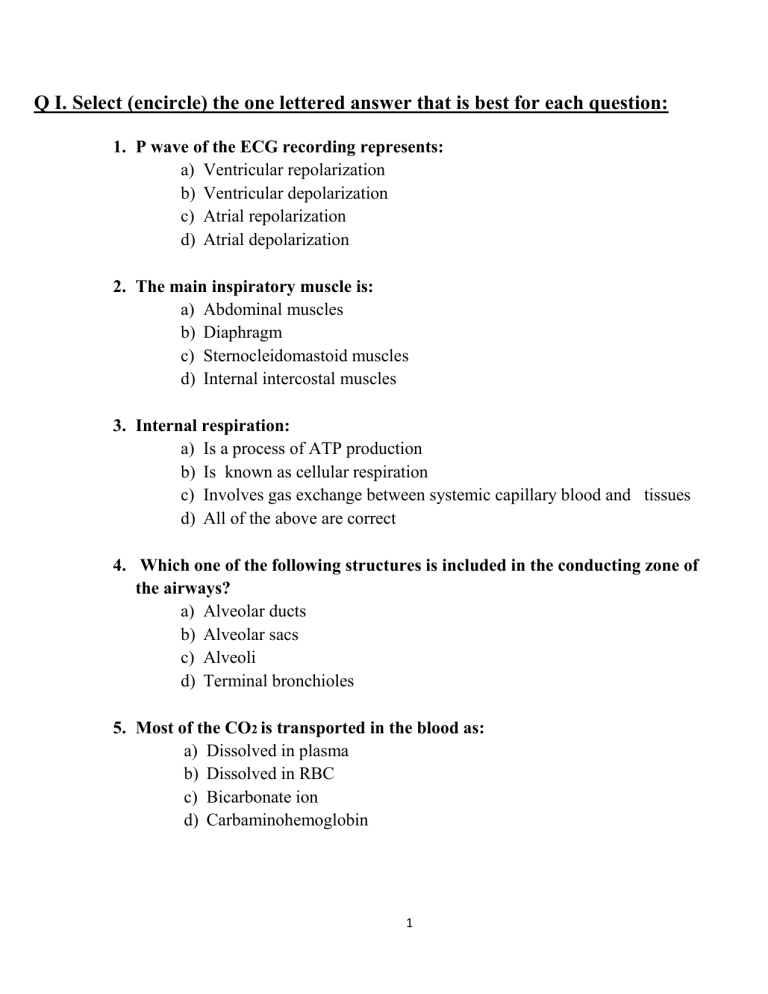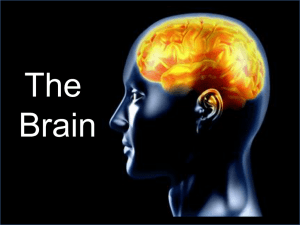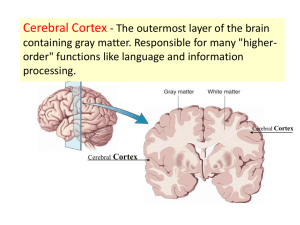exam
advertisement

Q I. Select (encircle) the one lettered answer that is best for each question: 1. P wave of the ECG recording represents: a) Ventricular repolarization b) Ventricular depolarization c) Atrial repolarization d) Atrial depolarization 2. The main inspiratory muscle is: a) Abdominal muscles b) Diaphragm c) Sternocleidomastoid muscles d) Internal intercostal muscles 3. Internal respiration: a) Is a process of ATP production b) Is known as cellular respiration c) Involves gas exchange between systemic capillary blood and tissues d) All of the above are correct 4. Which one of the following structures is included in the conducting zone of the airways? a) Alveolar ducts b) Alveolar sacs c) Alveoli d) Terminal bronchioles 5. Most of the CO2 is transported in the blood as: a) Dissolved in plasma b) Dissolved in RBC c) Bicarbonate ion d) Carbaminohemoglobin 1 6. Which one of the following facts is not correct regarding the surfactant? a) Its secretion is high in infant with respiratory distress syndrome b) It is a mixture of protein and lipid c) It decreases in the lungs of heavy smokers d) It is secreted from type II cells of the lung alveolar epithelium 7. The normal stroke volume in adult male is: a) 100 ml/beat b) 70 ml/beat c) 50 ml/beat d) 30 ml/beat 8. Second heart sound is caused by : a) Rapid ventricular filling b) Blood turbulence during atrial systole c) Closure of both atrioventricular valves d) Closure of the pulmonary and aortic valves 9. The highest conduction velocity of the cardiac impulse is in the: a) Av node b) Atrial muscles c) Ventricular muscles d) Purkinje fibers 10.In which of the following conditions, the heart rate becomes low? a) Emotions b) Exercise c) Sleep d) Fever 11.The lowest velocity of blood flow is in the: a) Aorta b) Large arteries c) Vena cava d) Capillaries 2 12.One of the followings is involved in the short-term regulation of arterial blood pressure: a) Renin-angiotensin system b) Kidney c) Aldosterone d) Carotid baroreceptors 13.Which one of the followings is the correct term for hemoglobin reaction with oxygen? a) Oxidation b) Oxygenation c) Oxidative phosphorylation d) None of the above is correct 14.Which one of the following factors affects maximally the O2 transport in the blood? a) Body temperature b) Plasma pH c) Hemoglobin concentration d) None of the above is correct 15.Which one of the following factors does not affect the dissociation of oxygen from hemoglobin? a) The blood pH b) The blood pressure c) The blood temperature d) None of the above is correct 16.The normal PCO2 of arterial blood is: a) 100 mm Hg b) 46 mm Hg c) 40 mm Hg d) None of the above is correct 3 17.Which one of the followings explains the term hypercapnia? a) Increased CO2 level in arterial blood b) Increased CO level in arterial blood c) Increased respiratory rate d) Increased respiratory depth 18.Which one of the followings produces spontaneous respiration (breathing)? a) The blood CO2 concentration b) The inspiratory center in medulla oblongata c) The vagal discharge d) None of the above is correct 19.During quiet respiration the volume of air inspired per breath is: a) 2000 ml of air b) 1500 ml of air c) 1000 ml of air d) 500 ml of air 20.The center for voluntary control of respiration is located in which one of the following parts of the brain? a) Spinal cord b) Cerebral cortex c) Midbrain d) medulla oblongata 21.Which one of the following autonomic reflexes is not integrated at the medulla oblongata? a) Regulation of blood pressure b) Contraction of full urinary bladder c) Swallowing act d) Vomiting 4 22. Which one of the following is not true about hypothalamus? a) It is a part of diencephalon b) It is divided into a variety of nuclei and nuclear areas c) It is involved in motor regulation d) It is involved in regulation of body temperature 23.Which one of the following structures is responsible for cognition? a) Thalamus b) Medulla oblongata c) Cerebral cortex d) Midbrain 24.The anterior spinothalamic tract is decussating at the level of: a) Medulla oblongata a) Pons b) Spinal cord c) Thalamus 25.Which one of the following structures is involved in the control of reflex movement of the head in response to voice stimulus? a) Superior colliculus b) Inferior colliculus c) Red nucleus d) Substantia nigra 26.The main function of the cerebellum is: a) b) c) d) Vision sensation Hearing sensation Coordination of movements of different joints None of the above is correct 5 27-All sensory stimuli pass through thalamus on their ways to the primary sensory areas of the cerebral cortex except: a) b) c) d) Taste sensation Vision sensation Smell sensation Touch sensation 28- Thalamus is part of the: a) b) c) d) Brainstem Midbrain Diencephalon Non of the above is correct 29-The signals from the cerebellum to the cerebral cortex for regulation of motor movement is: a) b) c) d) Inhibitory Excitatory Has no effect Non of the above is correct 30-The lateral geniculate nucleus is part of the: a) b) c) d) Basal nuclei Thalamus Hypothalamus Epithalamus 31-Which of the following structures is responsible for the control of biologic clock? a) b) c) d) Choroxid plexus Midbrain Pineal gland Non of the above is correct 6 32-The main structure which regulates hormones secretion from anterior pituitary gland is: a) b) c) d) Thalamus Hypothalamus Epithalamus Midbrain 33- The main function of the cerebral cortex is: a) b) c) d) Sensory perception Voluntary control of movement Thinking All the above are correct 34-The occipital cerebral cortex is responsible for: a) b) c) d) Taste sensation Vision sensation Smell sensation Hearing sensation 35- The main transmitter secreted by the basal nucleus (substantia migra) is: a) b) c) d) Acetylcholine Adrenaline Noradrenaline Dopamine 36-The motor speech area (Broca's) is located in the: a) b) c) d) Parietal lobe Frontal lobe Occipital lobe Temporal lobe 7 37-The temporal cerebral cortex is responsible for: a) b) c) d) Hearing sensation Touch sensation Vision sensation Non of the above is correct 38- The main structure which regulates temperature is: a) b) c) d) Medulla oblongata Hypothalamus Epithalamus Wernikes area 39- The signals from the basal nuclei (ganglia) to the cerebral cortex for regulation of motor movement is: a) b) c) d) Excitatory Inhibitory Has no effect Non of the above is correct 40- The main part of the brain responsible for the control of the autonomic nervous system activity is: a) b) c) d) Thalamus Midbrain Hypothalamus Epithalamus 41- Which one of the following is not present in Parkinson's disease : a) b) c) d) Tremor Difficulty in initiation of voluntary movement Difficulty in walking Flaccid paralysis 8 42- Which one of the following neurons goes under degeneration in Parkinson's disease: a) b) c) d) Dopaminergic Beta-adrenergic Alpha- adrenergic Cholinergic 43-The endocrine hormones in general are responsible mainly for the control of: a) b) c) d) Metabolism of the body Growth Reproduction All the above are correct 44-One of the following endocrine glands is considered as mixed gland: a) b) c) d) Thyroid Parathyroid Pancreas Adrenal 45- Which one of the following is the site for integration of respiration and heart regulation? a) b) c) d) Spinal cord Medulla oblongata Pons Midbrain 46-Oxytocin hormone is secreted by the: a) b) c) d) Anterior pituitary gland Posterior pituitary gland Pineal gland Non of the above is correct 9 47- Which one of the following structures is not influenced by insulin in respect to glucose entry to cells? a) b) c) d) Adipose tissue Hepatic cells Skeletal muscle Brain cells 48-- Which one of the following substances is required for the normal biosynthesis of thyroxine? a) b) c) d) Cholesterol Thyroid stimulating hormone Calcium Manganese 49-The fight and flight response to sympathetic nervous system overactivity includes: a) b) c) d) Increased respiratory rate Increased heart rate & cardiac output Glycogenolysis All of the above are correct 50- Which one of the following adrenal hormones is not influenced by the adrenocorticotropic hormone (ACTH) from the anterior pituitary gland: a) b) c) d) Epinephrine Glucocorticoid Mineralocorticoid Androgen 51- Which one of the followings hormones has the greatest effect on sodium retention: a) b) c) d) Glucocorticoid Antidiuretic hormones Aldosterone Androgen 10 52-The parathyroid hormone: a) b) c) d) Increases the level of plasma phosphate Decreases the level of plasma phosphate Has no effect on phosphate homeostasis Non of the above is correct 53-The effect of glucocorticoid hormone secreted following long-term response to stress are a) Proteins are broken down b) Fats are broken down c) Increased blood glucose d) All of the above are correct 54-The parathyroid hormone increases plasma calcium level by acting on the: a) b) c) d) Kidney liver Spleen All of the above are correct 55- Which one of the following food constituents is essential for the synthesis of steroid hormone? a) b) c) d) Carbohydrate Cholesterol Protein Amino acid 56- Which one of the following hormones has the greatest effect on plasma osmolality? a) b) c) d) Cortisol Androgen Vasopressin Dehydroepianderosterone 11 57-The main hypothalamic nucleus responsible for the production of antidiuretic hormone (ADH) is: a) b) c) d) Suprachiasmatic nucleus Supraoptic nucleus Paraventricular nucleus Superior colliculus 58-Oxytocin hormone: a) b) c) d) Is produced by the hypothalamic paraventricular nucleus Its secretion is controlled by positive feedback mechanism Facilitates milk flow from mammary gland All of the above are correct 59-Which one of the following hormones has no effect on the body growth? a) b) c) d) Growth hormone Thyroxine Vasopressin Non of the above is correct 60- Which one of the following types of hormone is secreted by the atrium of heart? a) b) c) d) Antidiuretic Antihypertensive Hyperglycemic Natriuretic 12







